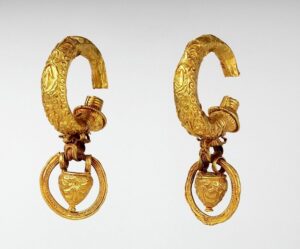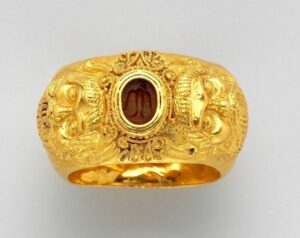
Jewels of big dimensions, opulence and splendour, cascades of gold: nowadays it is not unusual to see increasingly lively creations being showed, for whose realization the goldsmiths sometimes make use of very ancient techniques such as granulation and filigree. The contemporary jewel, which due to its exuberance becomes more and more central as a distinctive stylistic element, rests on an extremely fascinating tradition. To better understand it, we need to travel back in time to approximately three millennia ago, to explore the goldsmith’s art of the greatest pre-Roman civilization of Italy: the Etruscans.
The Etruscan civilization, which reached its maximum expansion between the VII and VI century BC, coming to control most part of central-western Italy, was known for its freedom of customs and for its extreme love for luxury and splendour. Its dedication to the pleasures of life, including opulent banquets, games and shows, was so strong that it even led to the ruin, according to the philosopher Posidonius, of people who were formerly strong warriors. Such splendour resulted in the flowering of a sumptuous goldsmith’s art, aimed at showing and flaunting the wealth of the Etruscan aristocracy.
Especially starting from the VIII century BC, the Etruscan princes increasingly required the production of jewelry, with the aim of expressing their status through rich personal ornaments. In particular, it was used gold, whose processing in Etruria began as early as the IX century BC, for the creation of marvellous fibulae (brooches) or garment decorations.
The Etruscan women, free and emancipated, had an eminent position within the society, and loved to adorn themselves by wearing very rich jewelry, including bracelets, earrings and fibulae. The latter probably represented the most popular ornament during the Iron Age. Initially, they were rarely made entirely of gold, but rather of bronze, embellished, for example, by windings of golden thread. Typical was the sanguisuga-type fibula, so-called due to its characteristic shape. The female taste was also addressed to elegant hair clips in the shape of spirals as well as to necklaces often decorated with pearls and amber or vitreous glass paste pendants.
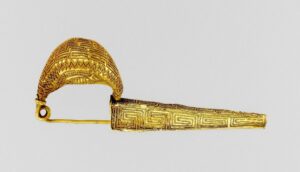
In particular, the magnificence of the goldsmith’s art characterized the so-called “Orientalizzante” era, between the end of the VIII and the beginning of the VI centuries BC. During this historical moment, the Etruscans were influenced by numerous contacts with Eastern cultures, having a significant impact also on the goldsmith’s art. The foreign goldsmiths introduced some of the finest techniques in Etruria, including the granulation, which consists in the welding of small spheres or grains, preferably in gold, to a background foil according to a chosen design, and the filigree, which consists in bending or twisting thin threads of gold or silver, put together by welding joints. It was then the Etruscans who brought these processes to the pinnacle of perfection, by decorating magnificent pins, braid holders, earrings, necklaces, fibulae and bracelets with great mastery. Lost wax, repoussé, ronde-bosse technique were only some of the many sophisticated processes of which the Etruscan goldsmiths became masters over the centuries, in addition to the aforementioned granulation and filigree.
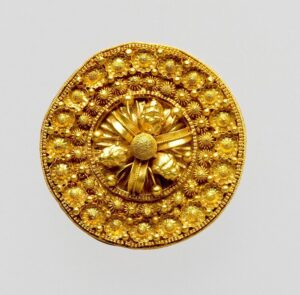
Thanks to the oriental influence, during the Orientalizzante period, were increasingly represented, throughout the jewels, creative and bizarre anthropomorphic figures and imaginary animals such as griffins, bulls and chimeras. In particular, fibulae often represented animals like horses, dolphins, ducks, beside winged lions, sphinxes and other fantastic creatures.
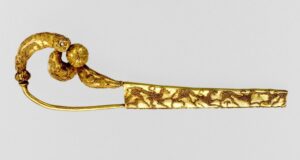
Rings, especially in gold or in golden silver, had also a central role. It was always recurring the figurative imagery composed of a very rich variety of imaginative creatures. Around the middle of the VI century BC, during the era called Archaism, prospered a new type of ring, with a revolving scarab stone: the latter, frequently carnelian or onyx, was engraved to represent figures derived mainly from Greek mythology. The influence of Greek artists was increasingly relevant to the archaic Etruscan goldsmith’s art.
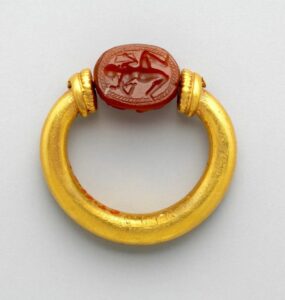
Women’s absolute favorite jewels were in all probability the earrings. Around the VI century BC, were very appreciated those in the shape of disks, deriving from the Greek-oriental fashion. The exuberant sizes of these jewels were remarkable, to the point of completely covering the ear: just think that some earrings could exceed 7 cm diameter. Very widespread were also “a baule” earrings, so-called due to the shape given by the curved rectangular gold foil which was closed by a small circular lid.
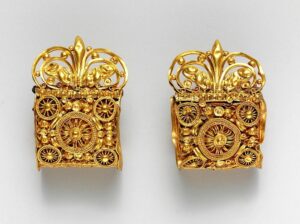
In the IV century BC, in the classical era, flourished earrings in the shape of “grape clusters”, undoubtedly one of the most popular jewels of the time, along with necklaces, diadems, discoid bullae and large breastplates, both for men and women, on whose surface were depicted complex mythological scenes.
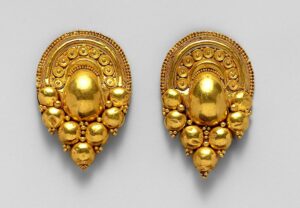
Jewelry as status symbol used to accompany the Etruscans even in life after death. In fact, in religiosity, one of the fundamental aspects in the Etruscan civilization, the conception of the afterlife was central: it was believed that the deceased would continue to live in his grave, and therefore he would be buried along with his wealth, as well as food and drinks. This is the reason why the main goldsmith findings, as well as the greatest artistic expressions of the Etruscan culture, are related to the burial.
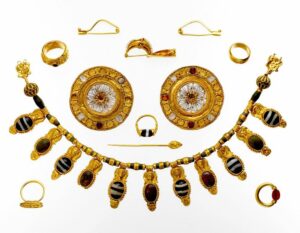
The time travel in the Etruscan civilization allows us to understand the incredible affinity to our own culture and our way of being in many aspects: from the freedom of customs to female emancipation, to taste. We discover a past which seems to mirror the present. After all, it is sufficient to look around to immediately see the legacies of the Etruscan goldsmith’s art in today’s jewelry, and to recognize our own roots. And even though many aspects of the Etruscan civilization are still today considered enigmatic and mysterious, what is certain is that it reached an extraordinary level of goldsmith mastery and creativity, capable of influencing contemporary style and our concept of elegance and sophistication.
